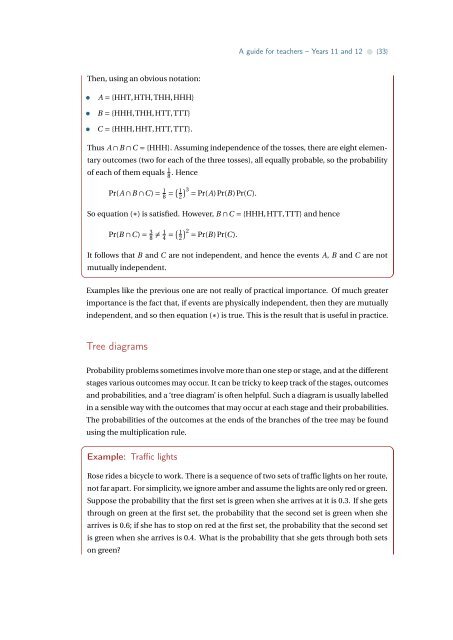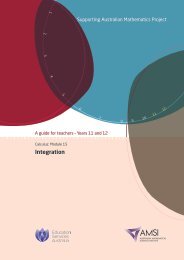Probability - the Australian Mathematical Sciences Institute
Probability - the Australian Mathematical Sciences Institute
Probability - the Australian Mathematical Sciences Institute
- No tags were found...
You also want an ePaper? Increase the reach of your titles
YUMPU automatically turns print PDFs into web optimized ePapers that Google loves.
A guide for teachers – Years 11 and 12 • {33}Then, using an obvious notation:• A = {HHT,HTH,THH,HHH}• B = {HHH,THH,HTT,TTT}• C = {HHH,HHT,HTT,TTT}.Thus A ∩ B ∩C = {HHH}. Assuming independence of <strong>the</strong> tosses, <strong>the</strong>re are eight elementaryoutcomes (two for each of <strong>the</strong> three tosses), all equally probable, so <strong>the</strong> probabilityof each of <strong>the</strong>m equals 1 8 . HencePr(A ∩ B ∩C ) = 1 8 = ( 12) 3 = Pr(A)Pr(B)Pr(C ).So equation (∗) is satisfied. However, B ∩C = {HHH,HTT,TTT} and hencePr(B ∩C ) = 3 8 ≠ 1 4 = ( 12) 2 = Pr(B)Pr(C ).It follows that B and C are not independent, and hence <strong>the</strong> events A, B and C are notmutually independent.Examples like <strong>the</strong> previous one are not really of practical importance. Of much greaterimportance is <strong>the</strong> fact that, if events are physically independent, <strong>the</strong>n <strong>the</strong>y are mutuallyindependent, and so <strong>the</strong>n equation (∗) is true. This is <strong>the</strong> result that is useful in practice.Tree diagrams<strong>Probability</strong> problems sometimes involve more than one step or stage, and at <strong>the</strong> differentstages various outcomes may occur. It can be tricky to keep track of <strong>the</strong> stages, outcomesand probabilities, and a ‘tree diagram’ is often helpful. Such a diagram is usually labelledin a sensible way with <strong>the</strong> outcomes that may occur at each stage and <strong>the</strong>ir probabilities.The probabilities of <strong>the</strong> outcomes at <strong>the</strong> ends of <strong>the</strong> branches of <strong>the</strong> tree may be foundusing <strong>the</strong> multiplication rule.Example: Traffic lightsRose rides a bicycle to work. There is a sequence of two sets of traffic lights on her route,not far apart. For simplicity, we ignore amber and assume <strong>the</strong> lights are only red or green.Suppose <strong>the</strong> probability that <strong>the</strong> first set is green when she arrives at it is 0.3. If she getsthrough on green at <strong>the</strong> first set, <strong>the</strong> probability that <strong>the</strong> second set is green when shearrives is 0.6; if she has to stop on red at <strong>the</strong> first set, <strong>the</strong> probability that <strong>the</strong> second setis green when she arrives is 0.4. What is <strong>the</strong> probability that she gets through both setson green?
















